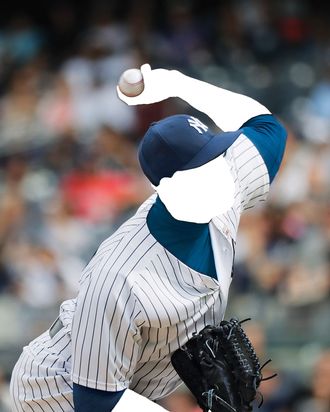
On July 26, the New York Yankees beat the Houston Astros 6-3 to reach a season-high four games over .500 and sneak within four games of the Boston Red Sox for one of the American League wild-card spots. That same night, the Mets won the second game of a doubleheader against the St. Louis Cardinals to go seven games over .500 and within four-and-a-half games of the first-place Washington Nationals. The two teams were roughly in the same spot in the standings. For one of the few times in their history, the Yanks and Mets were right next to each other.
Then, like it always seems to in baseball, it turned, just like that — each team lost its next four games. Their timing was impeccable. The losses ran right up to the August 1 trade deadline, the unofficial inflection point for middling teams like the Mets and Yankees. Are they trying to win this year, or are they tearing it down and building for the future? August 1 is the date by which you must have the answer: In or out?The Mets, still smarting from losing the World Series last year (as well as lingering concerns about the long-term health of their stable of young pitchers) and appearing as panicked as #MetsTwitter on any given Thursday night, decided to floor it, trading former top prospect Dilson Herrera and pitcher Max Wotell for Cincinnati Reds right-fielder Jay Bruce. Bruce is an odd choice for the Mets: In addition to being a low-on-base guy in a lineup that desperately needs base runners, he’s a corner outfielder on a team that already has four of them, all jockeying for playing time. It was a desperation trade by an organization that suddenly seems to be running out of time, trading the future for the urgent present. It was precisely the sort of trade the Yankees usually make.
Meanwhile, the Yankees, at last, started over. For years, it has been an untested axiom of New York City sports waggery that New York teams can’t tear down and rebuild like other cities’ teams can: New Yorkers won’t stand for anything but annual marches to a championship. (This tabloidy faux wisdom is almost exclusively responsible for the Knicks’ drunken swerves over the last two decades.) This year, Yankees general manager Brian Cashman finally got to test that principle the way he’s been wanting to for years. Cashman is a curious figure on the Yankees throne: He’s been with the have-cash-will-spend Yankees for three decades, but in his approach to roster management he is really a cousin of the Billy Beanes, the Theo Epsteins, the Jon Danielses of the sport — the Young Turk whiz kids who are constantly turning over their rosters and treating baseball like the wonkish Ivy League petri dish it has become. Cashman has stayed atop the food chain at Yankee Stadium by playing the old-school Steinbrenner–and–Randy Levine game, but he’s been waiting to do an Epstein-with-the-Cubs rebuild for years. At last, he got the green light.
So Cashman simply reconstructed the next decade of Yankees baseball in a matter of hours. With three trades of three players, the Yankees wouldn’t be needing the rest of the year anyway — Aroldis Chapman to the Cubs, Andrew Miller to the Indians, and Carlos Beltran to the Rangers — the Yankees revamped their whole farm system. They brought in top-shelf talent in bulk: shortstop Gleyber Torres, outfielders Clint Frazier and Billy McKinney, pitchers Justus Sheffield and Dillon Tate. If you don’t know those names — or Jorge Mateo, or Aaron Judge, or Gary Sanchez, or Blake Rutherford, all top prospects already in the Yankees system — don’t fret, you will. With the moves, the Yankees instantly shot to having the No. 2 farm system in all of baseball, according to MLB.com Pipeline, with seven of the top 100 prospects in the game. Going into the season, they ranked in the middle of the pack; in recent years, they’ve been close to the bottom.
And you know what? It was probably the happiest Yankees fans have been since Jeter left. Which is really pretty astonishing, given how reluctant New York organizations have always been to reboot — even when they knew (or should have known, in the case of the Knicks) that it was the wise approach. But a fire sale like this used to be a white flag, and nobody seemed less likely to tolerate surrender than New York fans. This time, amazingly, there was no real backlash, no cavalcade of angry WFAN callers at the gate screaming about the Yankees’ being “quittahs.” How did that happen, exactly? It’s a bigger story than the Yankees, or the back pages of the Post and Daily News. In an age of constant information, the average fan is far savvier about roster construction than they are given credit for. An impartial observer could always have seen that this was what the Yankees needed to do, but today, even the most partial has access to salary structures, prospect rankings, and playoff probabilities. Which has made fans, even the die-hard ones, reasonable.
This is true across sports — in the NBA, the Philadelphia 76ers just canned their longtime GM for failing to deliver on a massive, multi-season tanking project, though it took three years of unwatchable basketball — but it might be most true in baseball. The Houston Astros are one fantastic success, but for Yankees fans one need look no further than the Chicago Cubs, baseball’s most thrilling story, to see the fruits of reconstruction — they look on the verge of a decadelong dynasty. Record aside, you could tell this Yankees team was not going to win the World Series, and what fan wouldn’t want the chance to emulate what’s going on at Wrigley? Fans are not unreasonable people: If you have a plan and execute it, they will be with you.
It is worth noting that even the Yankees organization seemed to find the trade-deadline dumps an emotional transition — as did a couple of players. Within one week of the deadline, Mark Teixeira announced his retirement at the end of the season and, even more noteworthy, Alex Rodriguez agreed to retire as well, albeit more immediately (and after he made sure the Yankees will still pay him all the money they owe him through 2017). By finally building for the future, the Yankees at last cut ties with the past, and sort of amazingly, those players seemed okay with it. They might have been ready to move on with their lives too.
And boy, do the Yankees have a plan. For years, the nightmare scenario around baseball was that the Yankees would combine the principles of sabermetric, analytic roster construction — which argue strongly in favor of devotion to one’s farm system — with their massive payroll capability. Add youth to near-limitless financial muscle and you have a behemoth. This has been the Cubs’ plan, but the Cubs are no Yankees.
When I moved to New York in January 2000, the Yankees ruled the city in a way that seemed not just irreversible but eternal, as if they’d been here even before the Dutch. Friends who had lived here for decades said no. They remembered the mid-’80s; eventually the tide always turns, they said, and it’ll be a Mets town again, you watch. For about 18 months, it has been. But water always finds its level, gravity always pulls us down to Earth, and the Yankees always end up back on top. They are going to take over this town again, sooner than you think, and the next generation of Yankees dominance was forged at the end of July 2016, thanks to a perfectly timed losing streak. For years, Mets fans have said they can’t win for losing. The Yankees, being the Yankees, have now literally won for losing.
And suddenly, they look like they can own baseball soon. Sure, there will be some impatience among fans; it’s one thing to know a plan is being executed, it’s another to actually watch a team lose a ton of games over the span of a couple of years. Next season, maybe even the season after that, could be rough. But then: Get excited. The payroll could be near the $100 million mark, and maybe lower, before the 2019 season, which happens to be right when Bryce Harper, a superstar built to play in New York if ever there was one, hits free agency. If he’s not your speed, maybe Manny Machado, or Clayton Kershaw, or José Fernandez, or, heck, Matt Harvey is more your bag. Shoot, take two, three, four. The point is that with all the cheap young stars — baseball’s most valuable commodity — worming their way onto the roster, the Yankees will have the flexibility and muscle to go after the right free agents, ones still on the upside of their careers, and make deals that only the Yankees can make. The Yankees with a bundle of cost-controlled future stars and expiring contracts over the next three years and the best free-agent class in memory two years away? Look out. The Yankees are about to become a monster. Again.
*This article appears in the August 8, 2016 issue of New York Magazine.






























